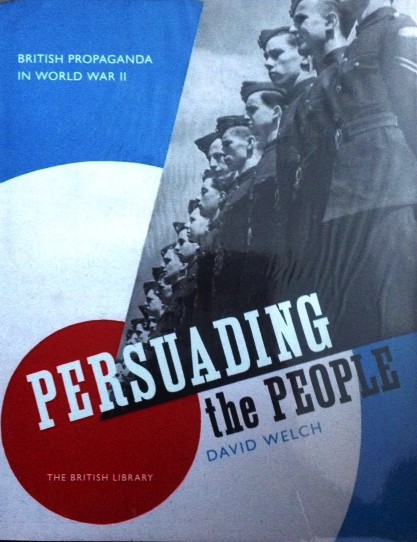Inspiring Older Readers
 posted on 08 Oct 2018
posted on 08 Oct 2018
Persuading the People by David Welch
I am constantly baffled by the economics of the publishing industry and never more so than when it comes to the issue of remaindered stock. I have to say that there are plenty of titles I’m flabbergasted ever get published in the first place and you don’t have to be a genius to see that a good proportion of those are going to end up being pulped. I’m also given to understand that there are quite a few titles that end up in discount remainder shops that were always intended for that fate in the first place – in other words, they were published as discount stock but masquerade as real, full price publications that have been marked down as bargains.
But why this fabulous production from The British Library should end up being sold for a measly few pounds in discount outlet I’ll never understand. David Welch’s Persuading the People is a truly beautifully produced publication that uses the British Library’s archive collection of famous, as well as previously unseen, booklets, posters, leaflets and other printed ephemera relating to World War Two propaganda. Welch has brought them together along with an informative text in a large format book that benefits from high quality paper and immaculate reproduction of the originals.
I’ve always felt that the title, Ministry of Information, is a sinister sounding, Orwellian name for any public body – your immediate response is to assume that their main business is government propaganda and that they are probably creative when it comes to the line between truth and falsehoods. But, of course, there are always times when propaganda isn’t a corrosive or shady practice but a necessary part of any government’s attempts to keep a public cohesive and motivated behind a particular line of action. There can be no better example of ‘good’ propaganda than that used during World War Two to bolster the will of the public to continue the fight against Fascism.
That is very much the territory that this publication is interested in. You’ll find here plenty of the slogans that have become famous careless talk cost lives or dig for victory type but you’ll also find plenty of others you have probably never heard of before and some others that were somewhat less successful and didn’t really get off the ground. Explanations of the historical context and the purposes behind the propaganda offensive are interesting enough but to be honest what interests me much more is the artwork that was generated to get these messages across.
I’m a big fan of poster art and I think it’s value is often chronically underrated and this book really does justice to just how creative these artists could be. I really would struggle to select what I thought were my favourites because I’d be stopping at every other page. What I can say is that I much prefer the illustrated posters to the ones based around photographs and I especially like the ones that clearly borrow from some the Soviet revolutionary propaganda tradition – the British version of the noble worker looking to the future is a decidedly less menacing one than the Russian version often gives you. Jaunty wives in headscarves with bonny babies and a pipe-smoking husbands give a distinctly less pugnacious image than the spanner-wielding, rock-jawed factory worker of the Soviet ideal.
Of course, the use of art for propaganda purposes also leads to the production of plenty of very bad art – chockfull of dreadful racist stereotypes and blind jingoism – and Welch hasn’t shied away from showing us this aspect as well. But when it’s good, it’s very good and I’d cite the magnificent Ruby Loftus Screwing a Bench Ring by Laura Knight which is an iconic painting illustrating the role women played in filling the gaps left by men in the factory and manufacturing environment. This is social realism employed to make a very clear message that isn’t just about everyone mucking in to help the war effort but also about the fundamental equality of men and women when it comes to skilled work. This was, depressingly, a message that was still largely ignored once the war ended with terrible consequences for gender equality right through to the current day.
This is definitely one of those books that reveals something new every time you pick it up. It’s a book to browse through if you wish or a book to read if you’re more interested in the detail and history of how the propaganda war was fought so successfully during this time. Either way it’s a treat. And, more astonishingly one you may still be able to find in your local remainder or bargain bookshop.
Terry Potter
October 2018